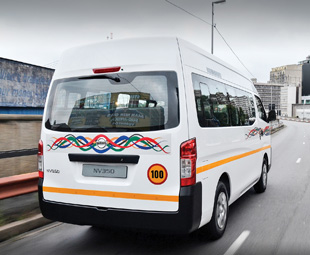A case for Minibus taxis

In the second part of our four-part series on public transport in Cape Town, MARISKA MORRIS takes a look at the minibus-taxi industry and how it could help reduce what is spent on the MyCiti bus rapid transit (BRT) system by 50 to 70 percent
The minibus-taxi industry provides transport to 91 percent of low-income households in South Africa. Despite being a R39-billion industry, minibus taxis are known to be unsafe with drivers speeding, driving dangerously and overloading.
Some specialists argue that the industry offers vital services and could possibly help to save the MyCiTi BRT system from its funding crisis. Aside from the day-to-day feeder services, minibus taxis also provide long-distance transport, offer transport to and from funerals for families over weekends and some even function as a meter-type service.
Another important service minibus taxis offer is after-hours transport, for example to restaurant staff. “When these places close at 23:00 or 23:30 at night, well after the last trains and buses have stopped operating, the staff need to get home,” says Roger Behrens, director of the Centre for Transport Studies (CfTS) at University of Cape Town.
Restaurants make arrangements with minibus drivers to transport these staff members. “Without minibus taxis, much of that kind of economic activity would not be possible,” Behrens notes.
Even more valuable, some believe, is the industry’s ability to possibly save the MyCiTi BRT system. The bus service faced a R52-million deficit for the 2016/17 financial year and the high level of subsidy necessary to support the service is unsustainable.
“The City of Cape Town cannot afford the MyCiTi service. It’s the Rolls-Royce of public transport systems,” argues Basil Nagel, taxi owner and spokesperson for the Retreat Taxi Association.
The Transport and Urban Development Authority (TDA) is considering a hybrid-transport system, which will incorporate minibus taxis on the MyCiTi bus routes. TDA estimates that this system could lead to a 50 to 70-percent reduction in bus transport costs. Before a hybrid transport system can be considered, however, there needs to be better understanding of the industry and its challenges.
“We talk about the taxi industry, but it’s a collection of thousands of businesses,” says Herrie Schalekamp, research officer at CfTS. Taxi associations are made up of multiple taxi owners with some preferring to act independently. There are an estimated 100 taxi associations operating in the City of Cape Town alone. These range from very formal to extremely informal businesses.
Some associations operate in part or in full as registered companies. Each fleet of minibuses is registered to the company. Some associations have an extensive bookkeeping process, pay taxes, maintain vehicles and even enter into formal contracts with other businesses; like the Peninsula Taxi Association, which entered into a formal contract with the University of Cape Town to assist in transporting students.
Other associations are less formal and may lack formal bookkeeping systems, do not declare income and operate without a licence, a requirement for all formal public transport service providers. The City of Cape Town estimates that only a third to half of the industry is operating legally.
While the business model of taxi owners may vary, they all work on a target system, which specialists argue results in hazardous driving and overloading. A taxi owner demands a specific amount from the driver for the day, usually R600 with a full tank of petrol. Whatever else the driver earns is his compensation.
“Moving drivers onto some kind of salary is essential to address some of these problems,” Behrens says. In theory, a basic salary would benefit both the owner and the driver. Many owners have an inaccurate perception of how well their business is doing because the driver doesn’t disclose the full amount earned, he adds.
Behrens says: “Very often drivers’ employment conditions are so bad that they have to do this in order to survive. A basic salary would offer drivers some stability, making them less likely to speed to meet their targets.”
The salary might include benefits similar to those found in formal-sector employment such as pension, medical aid, retrenchment procedures, sick leave and annual leave. It would meet the requirements of a formal employment contract. This would also give the government the ability to enforce labour laws and improve working conditions.
To accommodate this system, specialists suggest a cashless fare collection system similar to the MyCiTi MyConnect card. Passengers would pay by swiping or tapping the card. While the solution might seem simple, the South African National Taxi Council (Santaco) has struggled to implement it for a decade.
The biggest resistance to the cashless system comes from the drivers, which is an international trend. For example, a national pay system called BebaPay was introduced in Kenya. “Despite its benefits, it remains unused as drivers and conductors refuse to take the card,” explains Ken Griffith, consultant at Mobile Money Clearing House.
However, Santaco might still succeed. It launched its first successful pilot programme in Pietermaritzburg in 2015. A total of 115 minibuses were fitted with card-reading devices. Passengers preload cash on the free Fair Pay card or FairCard, which is then swiped inside the taxi.
The fact that these cards are free benefits low-income commuters who can’t afford the R30 once-off payment for the MyCiTi’s MyConnect card. Minibuses were fitted with a GPS to monitor speed and location. Santaco hopes to implement the system among various affiliated associations over the next four years and place taxi drivers on a salary.
While this is a step in the right direction, the industry still faces regular acts of violence, especially over routes. Nagel suggests a simple solution of coloured panels. Each vehicle would be registered to an area with an allocated colour. The nose panel or tailgate of the minibus would be painted in this colour. Nagel suggests revoking the licences of drivers who don’t follow their routes.
The quality of vehicles used in the industry also needs to be addressed, either with additional support from government, or by reviewing the Taxi Recapitalisation Programme, which was introduced in 1999 to replace unsafe, unroadworthy minibus taxis.
“Not nearly enough is allocated to buy new vehicles,” Behrens argues. The small trade-in of
R50 000 caused some controversy in June 2016, as it emerged that taxi operators were buying converted panel vans, which were unfit for carrying passengers. By law any private vehicle can be altered, but needs the appropriate permits before it can transport passengers.
These panel vans had windows cut out of their doors, which weakened the structure. Seatbelts
were fastened to the seat rather than the body of the van, and thus offered passengers no protection in an accident. These converted panel vans were much cheaper to purchase than a second-hand minibus.
While poorly converted panel vans should have been refused a permit, vehicle testing stations and licensing boards were blamed for not properly monitoring the process. “Drivers and owners should also receive formal training to avoid similar situations and allow them to professionalise their business,” Schalekamp notes.
“Where is the academy or college for a transport service provider? Train drivers and bus drivers are trained, so why not taxi drivers?” Nagel asks. Some believe that politicians are the biggest obstacle.
“Politicians want to be seen making a difference. A new bus service with fancy vehicles and stations is much more attractive than organising a scheme to support minibus-taxi owners and drivers in renewing their vehicles,” Schalekamp notes. “While the MyCiTi bus service might help win votes, it is too expensive to sustain.”
“We all know how to solve the problem, but we don’t take the industry seriously,” Nagel concludes. Perhaps by taking the minibus taxi industry more seriously as a transport provider, more affordable transport could be offered, which could, ultimately, save taxpayers valuable money.
Published by
Focus on Transport
focusmagsa



